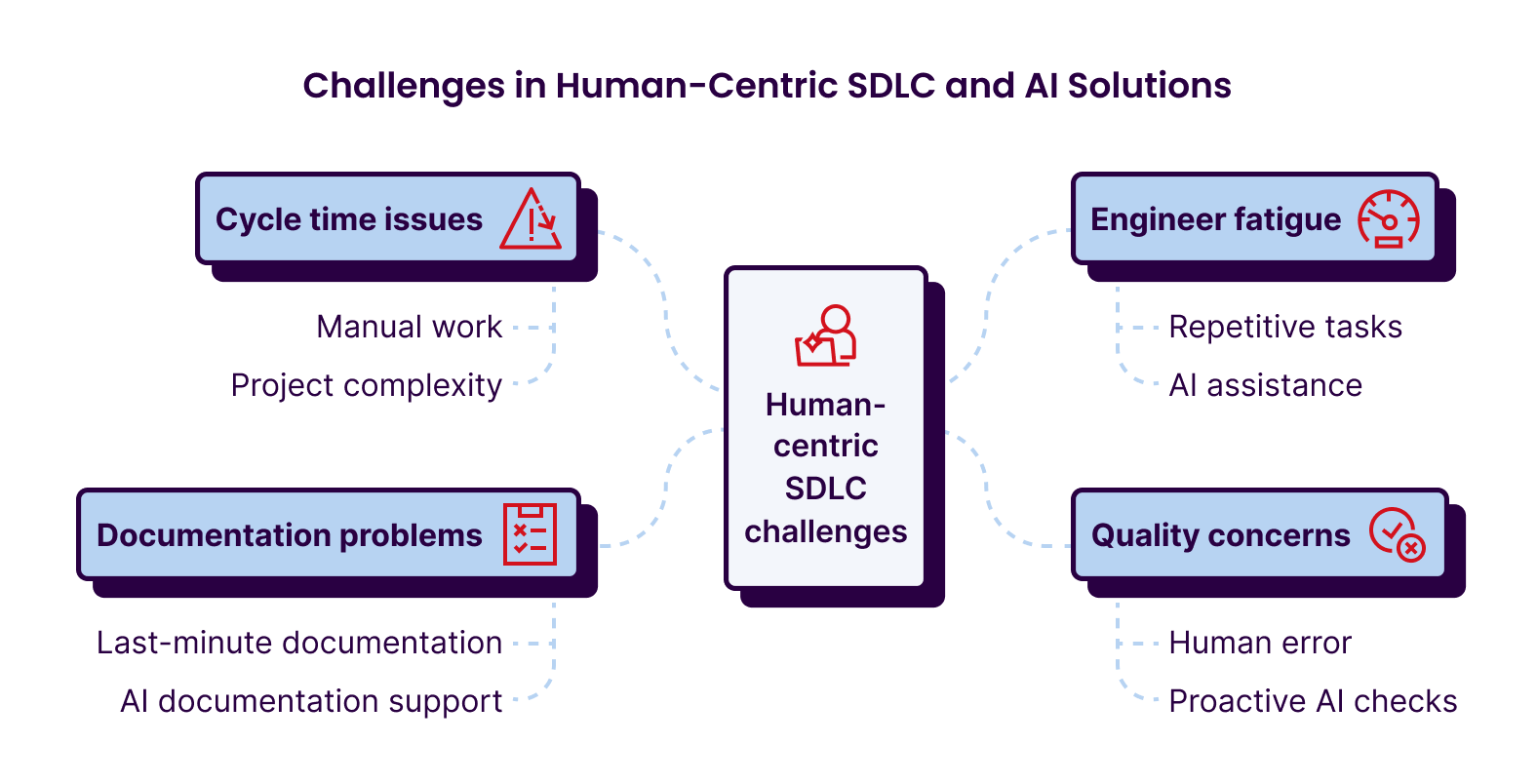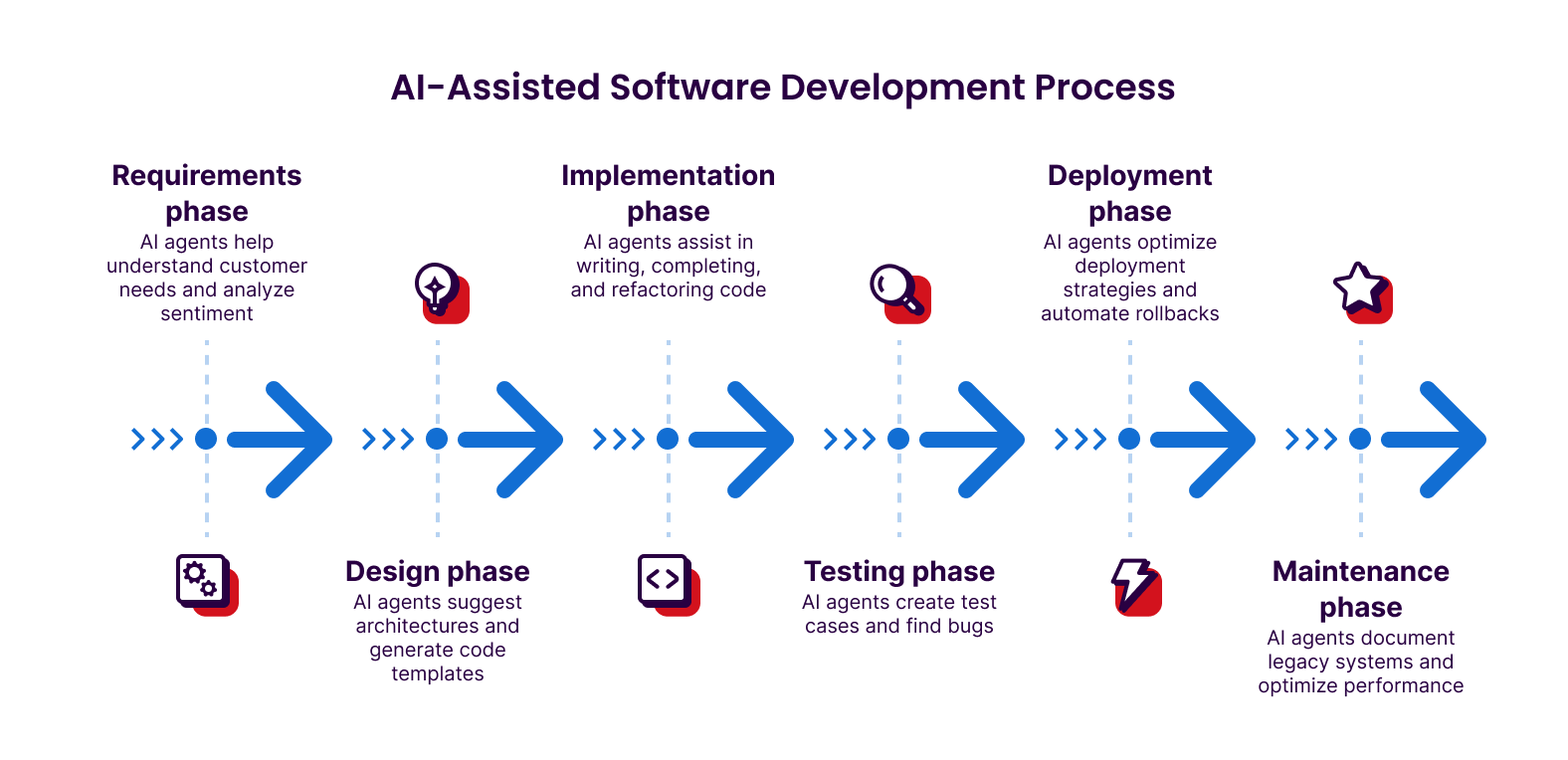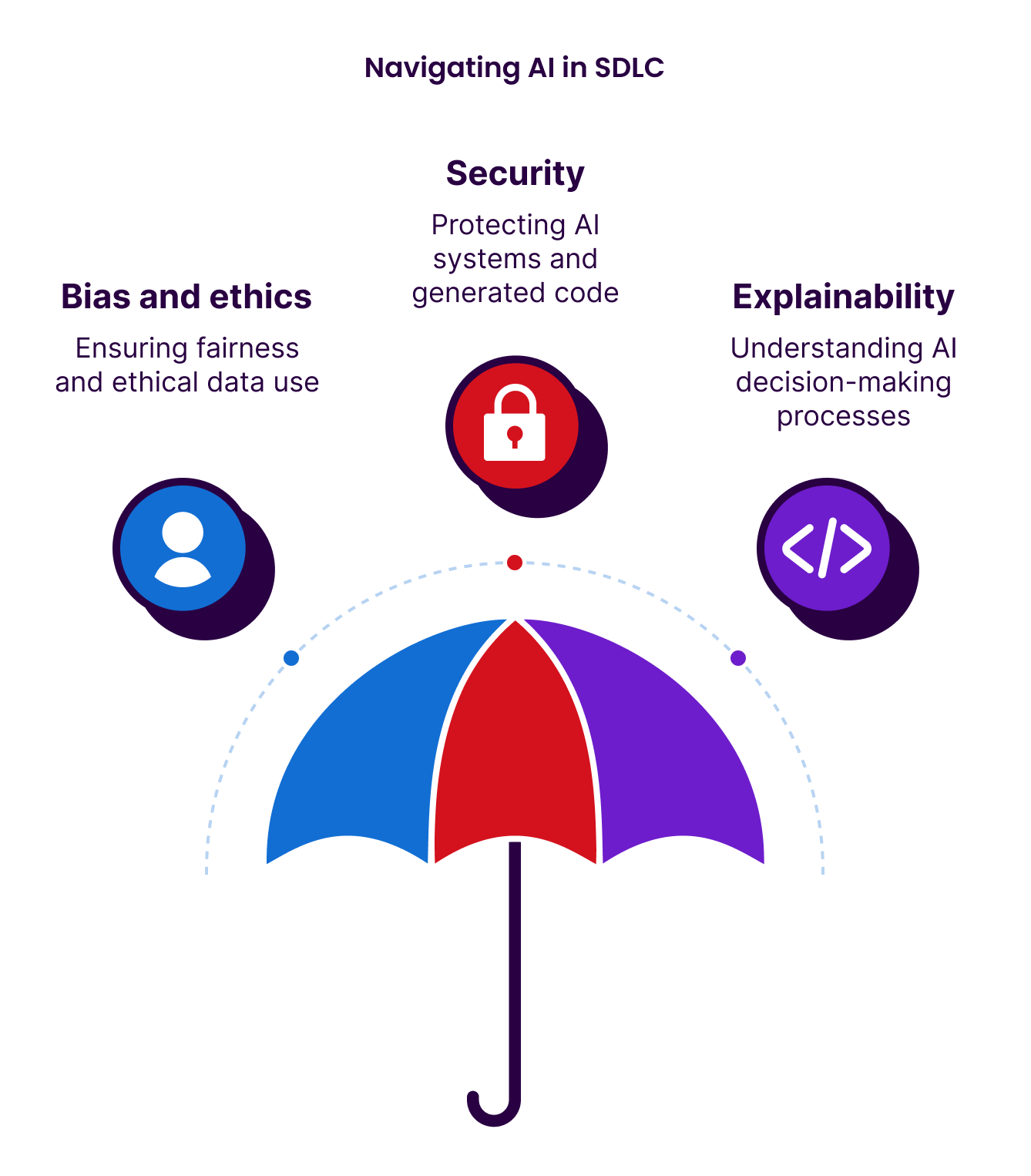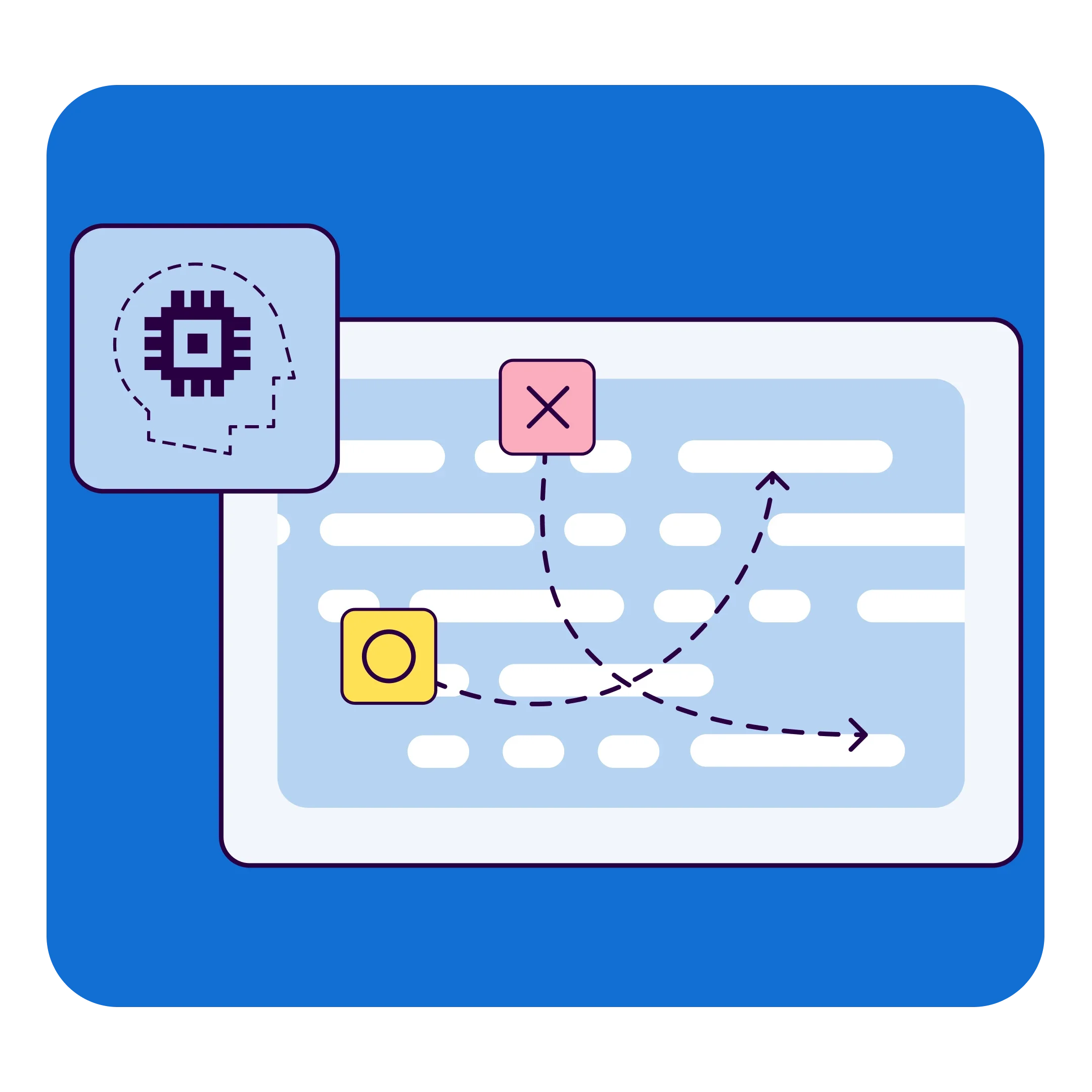Table of Contents
Start your free trial
Verify all code. Find and fix issues faster with SonarQube.
Get startedWhy AI Agents are Rewriting the SDLC Playbook
Let's be frank. Our current Software Development Life Cycle, often dominated by Agile methodologies like sprints and Jira, is showing its age. We, as engineers, are intimately familiar with the grind: the relentless sprint cycles, the constant firefighting of bugs, the ever-growing mountain of technical debt, and the persistent struggle to accurately predict project timelines using velocity metrics. Seriously, in an era of LLM, are we truly content with an iterative process that often feels more reactive than proactive? Is this the peak efficiency we can achieve in software creation? I argue, definitively, no.
Emerging research, detailed in paper from AutoCodeRover, points to a significant evolution in our field: the rise of AI Agents. These aren't just incremental improvements to our existing toolchains. We're talking about a fundamental shift towards autonomous, intelligent entities capable of participating in and even orchestrating the entire SDLC. Imagine agents powered by advanced neural networks, moving beyond simple task automation to become genuine collaborators in software development.
Consider the potential: AI agents that proactively analyze requirements and suggest design architectures, going beyond mere code completion to architect entire modules with deep contextual understanding. Envision intelligent testing agents that continuously monitor code quality, algorithmically generating comprehensive test suites far exceeding the scope of manual testing. Even the often-neglected area of documentation can be addressed by these agents, creating up-to-date and accurate documentation as a continuous process.
So, are you ready to adapt our processes to this paradigm shift? Are you prepared to move beyond rigid, sprint-centric workflows and embrace a more fluid, AI-augmented SDLC? Are you willing to explore the potential of collaborating with these intelligent agents, not as mere assistants, but as partners in building software with unprecedented speed and intelligence?
This isn't just a minor tech upgrade; it's an algorithmic reformation of software development itself. It's about fundamentally rethinking how we approach the entire lifecycle. And as engineers on the front lines of this change, we must ask ourselves: Are you ready to lead this evolution?
Why Human-Centric SDLC is Holding Us Back
You know, if you think about it honestly, our software development process, the way we do things normally, has too many problems. We try to make it better, better, better all the time, but still, something feels stuck, right? It’s like we’re trying to drive fast on a highway, but there's always a traffic jam. Let's talk about where all this jam is coming from in our SDLC.

- Cycle Time Slow, Things Getting Stuck: Do you ever feel like projects just… drag? Like, we start something, and then suddenly, months have gone by! Feedback takes forever, releases feel like a big deal instead of just happening. The main reason is too much human work, too much manual work. Think about it, every time we need to show code to someone for review, wait for testing to finish, get approval from someone else. Each step takes time. Small time, small time, but all together, big delay. Especially in big projects, this becomes a real problem, like a blocked pipe. We want to go fast, but everything just slows down. And with projects becoming more complicated every day, this problem is only getting worse. All this human work in SDLC is making us slow.
- Engineers Getting Tired, Brains Getting Full: Human beings, we are not machines, ya? But sometimes, our SDLC makes us feel like machines! So much repetitive work, so much boring stuff. Unit testing again, and again, and again. Writing the same code pieces for the tenth time. Then, documentation, who likes to write documentation? All this boring work, it makes engineers tired, very tired. And if your brain is tired, you make mistakes, code quality goes down, and you can’t even think of new, cool things to build. It's like your phone, if you keep too many apps open, it hangs, right? Same with our brains! AI agents, they can take away all this boring work. Let them do the unit tests, let them write the basic code, let them even help with documentation. Then, engineers can focus on the real engineering, the interesting, brainy stuff. Does it make sense?
- Quality Low, Bugs Popping Up Everywhere (Human Error): You know we are human beings. We make mistakes. It’s normal. Even if we are careful, bugs will happen. And manual testing, it’s good, but humans cannot check everything. We miss things. And our current SDLC, it's a very “find bug after it’s introduced” kind of process. We write code, then we test, then we find bugs. It’s reactive, like chasing after a thief who has already stolen something! What if we could be proactive, like police stopping the thief before he steals? AI can do continuous quality checks, find problems early, maybe even prevent bugs in the first place! That’s a big difference. Better quality, less headache later.
- Documentation (Always Left for Last): "Documentation is king!" Everyone says it, but who actually loves doing it? Nobody. We all push it to the end, and then, it’s rushed, incomplete, outdated by next week. And then, new engineers join the team, they cannot understand the old code. Maintenance becomes a nightmare. Fixing old bugs, impossible. Documentation gap, it’s a big problem. But AI agents, they can help here also. They can write documentation automatically, keep it updated with the code changes. Like magic! This can really change how we manage project knowledge, making things so much smoother.
- Scaling Up, Changing Fast – SDLC Cannot Keep Up: Today’s world, everything changes fast. Requirements change, market changes, everything changes! And our old SDLC models, even Agile, are sometimes too fixed. Like, Waterfall is a dinosaur, Agile is better, but still, it can be rigid when big changes come. If you need to scale up a team fast, SDLC struggles. If you need to change direction suddenly, SDLC struggles. It’s like driving a big truck, difficult to turn quickly. AI agents, with their algorithmic brain, can be more agile in the real sense. They can help us re-plan fast, re-allocate resources dynamically, and adapt to changes in real-time. That kind of flexibility, our current SDLC, is missing, I think.
These are not just theoretical limitations. These are the daily realities faced by engineering teams across the industry. These bottlenecks, this burnout, these quality issues, this documentation debt, and this struggle for scalability, are all symptoms of a human-centric SDLC model reaching its limits. But within these challenges lies the opportunity, the very need, for a new paradigm, one where intelligent algorithmic agents become integral partners in the software creation process. The prophecy of the AI Agent is not just about automation; it’s about fundamentally overcoming these inherent limitations and ushering in a more efficient, sustainable, and ultimately, more human-empowering era of software development.
Enter the Agent: The Algorithmic Collborators of Tomorrow's Software
So, we just talked about all the problems of our current SDLC. Slow, tiring, buggy, undocumented. But don’t worry, because just when things look darkest, light is here! And that light is AI Agents. You might be thinking, "AI, AI, everyone is talking about AI, what’s the big deal now?" But trust me, this is different. This is not just another tool. AI Agents, they are like, imagine you have a super-smart, super-fast engineer, but this engineer never gets tired, never makes mistakes from being sleepy, and can work 24/7. That’s kind of what AI Agents are, but even more!
See, these Agents, they are not just doing one thing, like running tests or writing code snippets. They are agents, like in movies, they can act on their own, they can perform reasoning, they can make decisions within the SDLC process. That’s the “autonomous” part, which means they can work without you holding their hand every second. And they are “proactive,” meaning they don’t just wait for you to tell them what to do, they see problems coming, they suggest solutions, they take initiative. This is not just automation, this is intelligent help, real engineering help, from algorithms!
How do they do this magic? Basically, they use super-brainy computer models, especially these “LLMs” – Large Language Models. Think of it like, they have read all the code in the world, all the books about software, all the discussions online. So they understand code, they understand engineering problems, they understand context, much better than just normal programs. And they use this knowledge to help us in every step of SDLC! Let me break it down, phase by phase:

- Requirements Phase – Understanding What We Need, Like a Mind-Reading Agent: First step, right? Understanding what the customer wants, what problem we are solving. Normally, this is all meetings, documents, back and forth emails. But AI Agents can help here! They can read customer documents, listen to meeting recordings (if you want!), and understand what is really needed. They can even do sentiment analysis. Like, check if the customer is happy or confused about the requirements! They can help us write better requirements documents, clearer user stories.
- Design Phase – Designing Like a Super Architect, Blueprint Ready! Next, we design the system, architecture, all that complicated stuff. Normally, senior engineers sit together, lots of diagrams, lots of discussions. AI Agents can jump in here also! They can suggest architectures based on the requirements, they can generate code templates for different parts of the system, they can even draw UML diagrams for you! Imagine, just tell the agent “I need a system for online shopping,” and it gives you a basic design, ready to go!
- Implementation Phase – Coding, Coding, Coding. But now with a Super Co-Pilot! This is where we spend most of our time, right? Writing code, fixing code, refactoring code. AI Agents, they are superstars in this phase. Code generation where they can write whole functions, whole modules, based on your instructions. Code completion where you start typing, they finish for you, perfectly. Code refactoring where you write bad code (we all do sometimes!), they can suggest better, cleaner code. And pair programming, imagine coding with an AI agent! It’s like having a super-experienced senior engineer sitting next to you, helping you every step of the way, but never getting tired or impatient.
- Testing Phase – Testing Like a Machine, Catching Every Bug! It is important, but boring and time-consuming. AI Agents, they love testing! They can automatically create test cases, much more than we could ever write manually. They can find bugs that humans would miss, especially those tricky edge cases. They can do security vulnerability scanning, always checking for weaknesses. And continuous testing agents, running tests all the time, in the background, so we catch problems immediately, not later when it’s too late.
- Deployment Phase – Deploying Smoothly, Like a Well-Oiled Machine. Deployment, getting the code live, can be stressful, right? Things can break, servers can crash, so many things to worry about. AI Agents can help here too! They can optimize deployment strategies, make sure everything is smooth and fast. They can provision infrastructure automatically, set up servers, networks, all that stuff. And if something goes wrong, they can even do automated rollback, like, undo the deployment if there is a problem, automatically! Less stress during deployment, more smooth releases.
- Maintenance Phase – Taking Care of Old Code, Like a Digital Gardener. Finally, maintenance. Old code, legacy systems, we all have them, and they are always a headache to maintain. AI Agents can help here too. They can understand old code, even if documentation is bad (or non-existent!). They can help you document legacy systems automatically. They can detect anomalies in production like, if something is behaving strangely, the agent will notice and alert you. And they can even do proactive performance optimization, make your old systems run faster and smoother.
AI Agents are not just for one small part of SDLC. They can help in every phase, from start to finish! They can make things faster, better quality, less tiring for engineers, and more adaptable to change. This is a big deal. This is not just automation, this is a revolution in how we build software. AI Agents are the solution we have been waiting for. The future is bright, and it’s powered by AI Agents!
Practical Steps to Embrace AI Agents in Your SDLC
Listen, I know what you might be thinking. “AI Agents sound amazing, but my company, we are not Google, we are not a fancy startup. How can we start using this AI stuff?” Don’t worry, it’s not rocket science. You don't need to change everything overnight. Small steps, slowly, we will get there.
- Start Small, Think Big, But Start Small:
First thing, don’t try to change everything at once? Don’t suddenly say, “Okay, from tomorrow, full AI SDLC!” Instead, find one small area in your SDLC that is giving you pain, and try to use an AI Agent there first. Maybe your unit testing is taking too long? Or the documentation is always late? Or are code reviews becoming a bottleneck? Pick one problem area. Then, find AI Agent solutions for that specific area. Try it out and see how it works, learn from it. Start small, but keep the big picture in mind, where you want to reach eventually with AI in your whole SDLC. Baby steps first.
- AI Agents are Your Friends, Not Your Replacement:
Think of AI Agents as super-helpful assistants, like really good junior engineers who are always ready to help. Focus on how AI Agents can help your developers, make them more productive, less stressed, more happy. Emphasize that AI Agents are developer allies, tools to empower them, not replace them. This is very important for your team to accept AI Agents.
- Explore, Explore, Explore – Tools and Platforms are Already Here:
Good news, you don't need to build AI Agents from scratch! There are plenty of tools and platforms are already available, some are even open source, free to use! Look for categories like code generation tools, AI-powered testing platforms, documentation automation software, all that good stuff. Try out free trials, play around with demos. See what tools fit your needs, your tech stack, your team. Don't be afraid to experiment. And don't just look at big, fancy tools. Sometimes, small, open-source projects, community-driven tools can be very useful and very flexible. Community support is also important. See what other engineers are using, what they are recommending.
- Train Your Engineers – Learning to Dance with the Algorithm:
Okay, you bring in AI Agents, but your engineers also need to learn how to work with them, right? It’s not like plug-and-play. Developers need to understand how to use these agents, how to guide them, and how to collaborate with them. It’s a new skill, “algorithmic orchestration”! So, invest in training, upskilling your team. Workshops, online courses, hands-on sessions, whatever works for your team. Make them comfortable with AI Agents, show them the benefits, help them become AI-augmented engineers. This is not just about learning tools, it’s about learning a new way of working, a new engineering mindset.
- Data is the King, Queen, and Everything:
Remember this, AI Agents are powered by data. With good data, they work like magic. But with bad data, they are useless. So, data is super important. Think about what data you have in your SDLC, where it is, how good it is. You need data for training AI Agents, for optimizing them, for making them work effectively for your projects. Think about data pipelines, how data flows into your AI Agent systems. Think about data governance, how to manage your data securely and ethically for AI use. Data strategy for AI-driven SDLC is very important, don't ignore this part. It's the fuel for the AI engine!
These are the practical steps. Start small, focus on helping developers, explore tools, train your team, and data! It’s not going to happen overnight, but if you start taking these steps now, you will be ahead of the game. You will be building the future of SDLC, step by step, with AI Agents as your partners. Ready to start walking this algorithmic path, boss? Let's go!
Addressing skepticism and concerns about AI-Driven SDLC
At Sonar, we are super excited about AI Agents, you know that by now. But if anyone tells you it’s all sunshine and rainbows, they are lying to you! There are challenges, there are worries, we need to be aware, we need to be careful. Let’s talk about some of the dangers and problems we need to think about with AI Agents in SDLC.

Bias and Ethics Problem – AI is not always fair. This is a big one, and very important. AI Agents, they learn from data, right? And if the data is biased, if it’s unfair, then the AI Agents will also be biased and unfair! Example, if AI learns from code written mostly by one type of engineer, it might not work well for other types of engineers, or for different kinds of projects. Or, if the data has some kind of built-in prejudice, AI can learn that also, and make software that is not good. So, we have to be super careful about the data we use to train AI Agents. We need to think about ethics, fairness, responsibility, right from the start. AI development cannot be just about technology, it also has to be about values, about doing good. Ethical AI SDLC is a must, & we cannot ignore this.
Security Problem – AI Agents can be attacked too. Security is always important in software and with AI Agents, we have new security risks to think about. First, AI Agents themselves, they can be attacked, like any software. If someone hacks your AI Agents, they can mess up your whole SDLC, very dangerous. Second, code generated by AI, we have to check it extra carefully for security holes. AI is good at many things, but security is tricky, subtle. AI-generated code might have vulnerabilities that are hard to find. So, the security mindset is even more important in AI-driven SDLC. We need to make sure AI Agents are secure, and we need to rigorously test AI-generated code for security issues.
Explainability Issue – “Black Box” problem, how Agents decide things. Some AI models, especially those big neural networks, are like �“black boxes.” They do amazing things, but sometimes, we don’t really understand how they do it, or why they make certain decisions. If an AI Agent suggests a code architecture, or finds a bug, but we don’t understand why. How do we debug if we don’t understand the logic? How do we trust AI if we don't know how it’s thinking? This “black box” problem is a challenge for AI in many fields, and SDLC also. We need to push for “explainable AI”. AI models that can explain their reasoning, show us why they are doing what they are doing. And we need better debugging tools for AI-driven SDLC, tools to help us understand and fix problems, even when AI is involved. Transparency and debuggability are crucial for trust and effective use of AI Agents.
These are some real challenges, some real worries. We have to face these problems head-on, be honest about them, and find solutions. We need to be responsible, ethical, and careful in how we bring AI Agents into our SDLC.
Get Ready for SDLC 2.0 with AI Agents!
Looking back at our discussion, one conclusion becomes undeniable: AI Agents represent not merely an incremental improvement, but a fundamental transformation of software development. They are poised to reshape the entire SDLC.
Imagine this, projects suddenly moving way faster. Releases aren’t these huge, months-long things anymore. Instead, you’re pushing out new features like… regularly. Weeks? Days? It’s actually possible! The software itself gets so much better. Fewer of those annoying bugs, systems that are solid as a rock, and even security built-in right from the start, like it should be!
And for us, the developers? Way less burnout, way more, enjoyment in the job. Imagine shedding all that boring, repetitive stuff. No more drowning in the tasks you dread. No more losing sleep over stupid bugs. Instead, we finally get to focus on the stuff we’re actually good at, the stuff that’s fun: coming up with cool new ideas, solving tricky problems, building genuinely innovative things, stuff that maybe we couldn’t even dream of doing before, because we were too busy putting out fires!
Just think for a minute about what that really means. Less time wasted on the stuff no one likes doing, and way more time on the stuff that actually uses our brains, the strategic thinking, the architecture, the creative leaps. We go from being, you know, just developers to becoming more like architects of algorithms, inventors of digital things, creative builders of the future. And AI Agents? They're not taking over, they're our partners, our AI co-pilots. They're helping us out at every step, making us super charged developers.
So, the big question: what happens next? Do we just sit back and hope this awesome future just magically appears? Nope, not happening. We gotta make it real. And that’s where our newest acquisition of AutoCodeRover comes in. This is a call to action, a chance to be part of something big – this Algorithmic Reformation.
